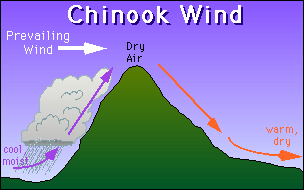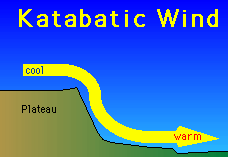Mesoscale Mechanical Circulations
The other main influence on mesoscale circulations is the topography of a region. Because the influence is mechanical rather than thermal, these are referred to as mechanically forced circulations. We will look at two examples of mesoscale circulations that form due to topography: chinook winds and katabatic winds.

Chinook is the name given to a wind that blows down the eastern slopes of the Rocky Mountains. Initially, wind blowing in from the west hits the mountain range and is forced aloft -- a mechanical process. As the air rises, it reaches its LCL, and the moisture in the air condenses, forming clouds. As the air continues to rise, most of its moisture is lost to precipitation so that by the time it reaches the top of the mountain range, it is extremely dry. The air then moves down the eastern side, adiabatically warming as it descends. The resultant wind is a very warm, dry wind.

Though technically meaning any wind that flows downslope, a katabatic wind usually represents wind with a higher magnitude than that of a mountain breeze. Typically, it is used to describe winds that move rapidly off a plateau into an adjoining valley. Like the Chinook, the air moves across the plateau and then warms adiabatically as it moves downward. If the air on the plateau is significantly denser than the air in the valley (because of temperature differences), then the denser air will rush downslope due to the pull of gravity (like water in a waterfall). Katabatic and chinook winds are examples of mesoscale winds that are forced by terrain.




Developed by
 The Shodor
Education Foundation, Inc.
The Shodor
Education Foundation, Inc.
Copyright © 1996



 The Shodor
Education Foundation, Inc.
The Shodor
Education Foundation, Inc.